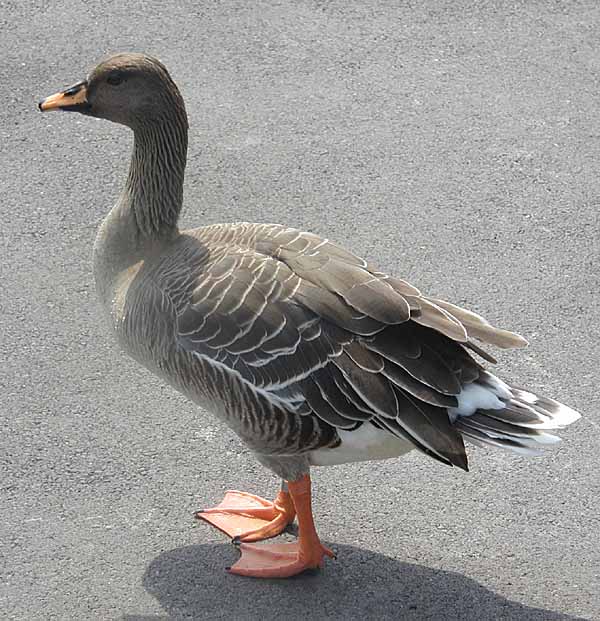|
| Query: Anser | Result: 13th of 443 | |
Bean Goose (Anser fabalis) - Wiki
| Subject: | Bean Goose (Anser fabalis) - Wiki
| |

| Resolution: 600x621
File Size: 86316 Bytes
Date: 0000:00:00 00:00:00
Camera: C3100Z,C3020Z (OLYMPUS OPTICAL CO.,LTD)
F number: f/2.8
Exposure: 10/5000 sec
Focal Length: 191/10
Upload Date: 2008:01:06 23:24:12
|
Bean Goose
From Wikipedia, the free encyclopedia
Order: Anseriformes
Family: Anatidae
[Photo] Bean Goose (Anser fabalis) at Slimbridge Wildfowl and Wetlands Centre, Gloucestershire, England. Taken by Adrian Pingstone (http://commons.wikimedia.org/wiki/User:Arpingstone) in June 2003 and released to the public domain.
The Bean Goose (Anser fabalis) is a medium-sized to large goose breeding in northern Europe and Asia. It has been split into two species by the AOU (2007) and the BOU (year?)--see below. It is migratory and winters further south in Europe and Asia.
The bill is black at the base and tip, with an orange band across the middle; the legs and feet are also bright orange.
The upper wing-coverts are dark brown, as in the White-fronted Goose (Anser albifrons) and the Lesser White-fronted Goose (A. erythropus), but differing from these in having narrow white fringes to the feathers.
It gets its English and scientific names from its habit in the past of grazing in bean field stubbles in winter (Latin faba, a bean).
There are five subspecies, with complex variation in body size and bill size and pattern; generally, size increases from north to south and from west to east. Some ornithologists (including AOU 2007) split them into two species based on breeding habitat, whether in forest bogs in the subarctic taiga, or on the arctic tundra.
Taiga Bean Goose (Anser fabalis sensu stricto)
A. f. fabalis. Scandinavia east to the Urals. Large; bill long and narrow, with broad orange band. Anser fabalis fabalis is one of the species to which the Agreement on the Conservation of African-Eurasian Migratory Waterbirds (AEWA) applies.
A. f. johanseni. West Siberian taiga. Large; bill long and narrow, with narrow orange band.
A. f. middendorffii. East Siberian taiga. Very large; bill long and stout, with narrow orange band.
Tundra Bean Goose (Anser serrirostris, if treated as a distinct species)
A. s. rossicus. Northern Russian tundra east to the Taimyr Peninsula. Small; bill short and stubby, with narrow orange band. Anser fabalis rossicus is one of the species to which the Agreement on the Conservation of African-Eurasian Migratory Waterbirds (AEWA) applies.
A. s. serrirostris. East Siberian tundra. Large; bill long and stout, with narrow orange band.
The voice is a loud honking, higher pitched in the smaller subspecies.
The closely related Pink-footed Goose (A. brachyrhynchus) has the bill short, bright pink in the middle, and the feet also pink, the upper wing-coverts being nearly of the same bluish-grey as in the Greylag Goose. In size and bill structure, it is very similar to Anser fabalis rossicus, and in the past was often treated as a sixth subspecies of Bean Goose.
Status in Britain
The Bean Goose is a rare winter visitor to Britain. There are two regular wintering flocks of Taiga Bean Goose, in the Yare Valley, Norfolk and the Avon Valley, Scotland. A formerly regular flock in Dumfries and Galloway no longer occurs there. Tundra Bean Goose has no regular wintering sites, but is found in small groups among other grey goose species - among the most regular locaities are WWT Slimbridge, Gloucestershire and Holkham Marshes, Norfolk.
http://en.wikipedia.org/wiki/Bean_Goose
| The text in this page is based on the copyrighted Wikipedia article shown in above URL. It is used under the GNU Free Documentation License. You may redistribute it, verbatim or modified, providing that you comply with the terms of the GFDL. |
|
^o^
Animal Pictures Archive for smart phones
^o^
|
|

